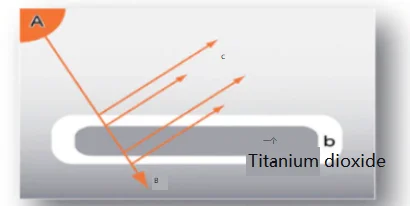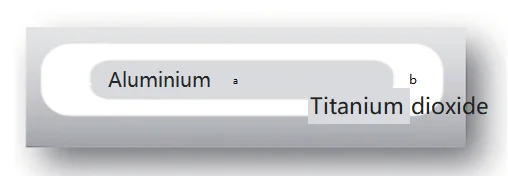What is Chameleon pigments?
From the perspective of coatings, “Chameleon Pigments” (scientific name: symphony pigment) is a special light interference pigment. It is a multiple layered flake pigment composed of aluminum, magnesium fluoride and chromium. The materials with such pigments, such as paint, coatings, plastics and textiles, can show different colors at different angles. The revolutionary light interference technology has been used in their manufacturing process. As long as the viewing angle and light incidence angle are different, each piece of pigment may show a colorful color.
How did chameleon pigments come about?
Chameleon pigment car paint is patented product of US Flex Company under the trademark “Chromaflair”. It is a micrometer-sized thin material formed by ultra-thin multi-layer interference films. It is characterized by opacity, thinness, flatness and high reflectivity. The color of chameleon pigments is generated from the interference phenomenon of light waves. This color has excellent mirror effect, high saturation and extremely high chromaticity (Fig. 1).

How Chameleon Powder Pigment Works?
In nature, we can observe phenomena of light interference, such as symphony colors of soap bubbles, shells and wings. The coloring principle of chameleon pigments is similar to the symphony phenomenon in nature. By precisely controlling the thickness of the interference film, each type of pigment can produce different symphony effects, such as green to purple, purple to orange and gold to silver. Therefore, we also call it “physical color” of the coatings industry.
The colors generated by chameleon pigments include absorption color and interference color: The absorption color refers to the color of the reflected light wave seen by the human eye after some light waves at specific wavelengths are absorbed, while the light waves at other wavelengths are reflected when a white light source (normally sunlight) passes through an object. It is an inherent characteristic of the object itself (Fig. 2).

The interference color is formed when the reflection of other lights is suppressed and that of certain lights is enhanced. The colors reflected by specially treated surfaces show different colors along with the angle of light incidence, which cannot be reflected by the “absorption light”. Therefore, several products of current chameleon pigments have no color themselves and their color effect is completely formed through the interference and absorption of light waves.
However, different from ordinary aluminum pigments and pearlescent pigments, chameleon powder pigments are neither mica nor aluminum powder. They are composed of special thin sheet materials with a layered structure with an opaque aluminum coating wrapped in the center (Fig. 3).

Chameleon pigment is a completely reflective material. It is a layered and thin sheet material with infinite color and composed of aluminum, magnesium fluoride and chromium. Moreover, propylene glycol n-propyl ether is used as a wetting agent to reduce pigment flying in use. Therefore, chameleon pigments have excellent weather resistance and light stability.
Chameleon pigments can be used together with aluminum powder, carbon black or other materials to produce various color effects. However, as these pigments reduce the saturation of coating colors, the transparent pigments can best reflect the saturation of symphony color. The reason is that they do not affect the light interference effect on the surface of the chameleon pigment and accordingly do not affect its color saturation.
The hiding power of chameleon pigments is unmatched by other special pigments. Due to the opaque nature of the material flakes, the chameleon pigment can provide good hiding power.
Due to high cost, only a little amount of chameleon pigments is added to coatings generally. For example, the recommended amount is 0.6% to 1.5% in topcoat, 2.4% to 5.9% in middle coat and 5.0% to 11.0% in primer coat. The coatings containing chameleon pigments are almost the same as ordinary coatings in application. We may use traditional air spraying or electrostatic spraying of automobile manufacturers in the application of repair paint.
The Application Status of Chameleon Pigments
In early 1996, Ford first painted 2,000 Cobra Mustangs in symphony colors, initiating the application of chameleon pigments in the automotive industry. Nowadays, many motor manufacturers have used chameleon pigments and leading models have emerged as well.
For GS models produced by Lexus China in 2008, the body color code was 1G5 pearl mica gray. In this color formula, a special “Magic Purple” P-999-CS32 chameleon pigment was used to generate multiple flip-flop effects, such as purple-silver, green-purple and blue-silver.
For Lexus UX models produced in 2018, the body color code was 3U3 supersonic agate red. In its formula, special “Crystal Ultra Red Pearl” P999-XR15 and “Amethyst Pearl” P999-XR16 chameleon pigments are used to produce a variety of flip-flop effects, such as light purple, purple-gold, red-golden yellow, gold-green and gold-blue.
In the field of repair paint, customers frequently using repair chameleon coatings have reported that repair of symphony colors is as easy as repair of traditional colors. It is probably due to that a significant color change helps to hide color differences, making it easier for the human eye to accept the repaired color. Generally, chameleon coatings are adjustable. However, fine adjustment to some coatings with special flip-flop effects and oversized flip-flop metal sheets is impossible at present, but adjustment to those with the primer of the same color is realizable. Common dark chameleon pigment uses three coats of black primer. For the chameleon pigments with large particles, it is required to spray 4-5 coats of varnish. So, they are not widely used in China at present.
However, chameleon pigments are not the preferred popular choice. In the future, due to regional differences and individual preferences of car owners, chameleon pigments will be more widely used in sports cars or modified cars.
CONTINUE READING
What processes can chameleon pigment powder be used in?
What are chameleon pigments used for?
Why is chameleon powder pigment so popular in the shoe industry?



